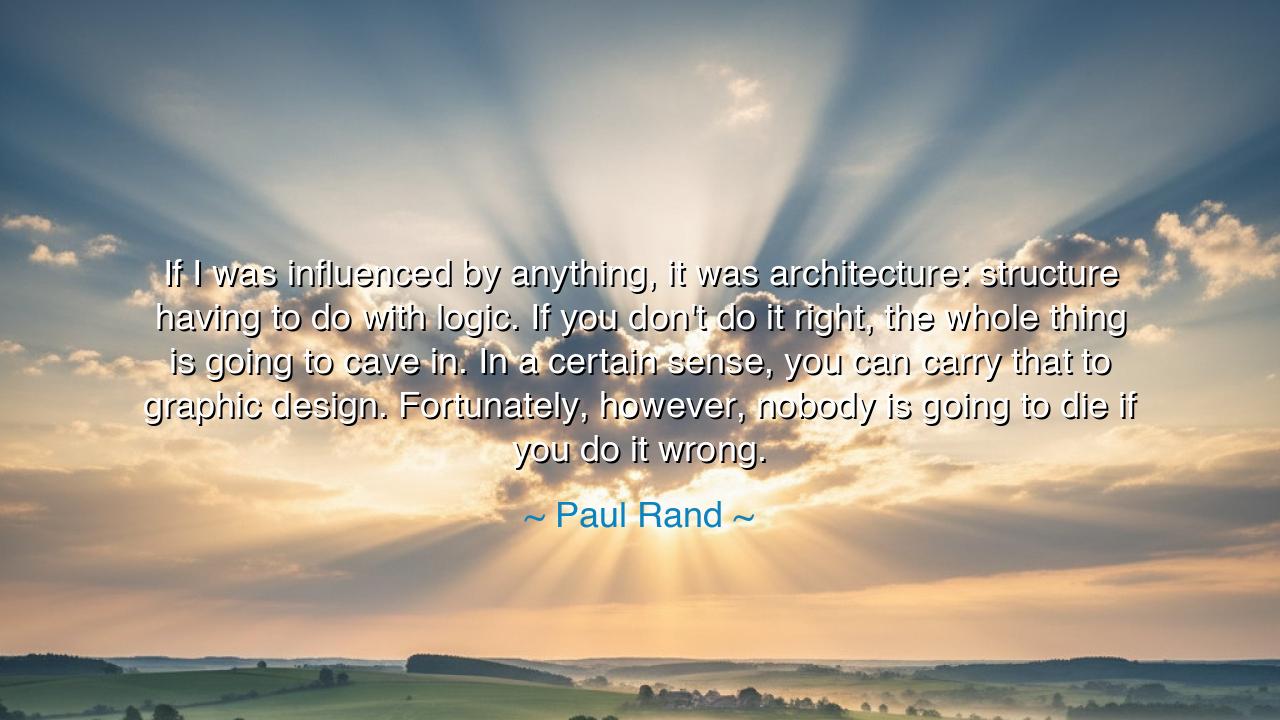
If I was influenced by anything, it was architecture: structure
If I was influenced by anything, it was architecture: structure having to do with logic. If you don't do it right, the whole thing is going to cave in. In a certain sense, you can carry that to graphic design. Fortunately, however, nobody is going to die if you do it wrong.






“If I was influenced by anything, it was architecture: structure having to do with logic. If you don’t do it right, the whole thing is going to cave in. In a certain sense, you can carry that to graphic design. Fortunately, however, nobody is going to die if you do it wrong.” Thus spoke Paul Rand, the master of modern design, the craftsman who gave identity to great companies and coherence to the chaos of visual thought. In these words, Rand unveils the essence of structure, logic, and responsibility in creative work. He speaks as both an artist and a philosopher—one who recognizes that design, though often seen as play or decoration, is built upon the same principles that sustain bridges, temples, and civilizations.
The origin of this quote lies in Rand’s deep reverence for the unity between beauty and reason. To him, design was not ornamentation—it was architecture of meaning. Just as an architect must calculate the forces of balance, weight, and support, so must the designer consider proportion, rhythm, and harmony. Every line, every space, every letter must serve a purpose; otherwise, the entire structure—whether a building or a poster—risks collapse. Rand’s comparison to architecture reveals his belief that design, when done rightly, is not a matter of intuition alone but of discipline guided by logic. It is creativity bound to structure, freedom made purposeful.
He reminds us, however, that design differs from the physical structures of the world in one merciful respect: “nobody is going to die if you do it wrong.” In this, there is both humor and humility. He acknowledges that while design may not bear the literal weight of a roof or bridge, it carries its own form of consequence. A poorly designed building collapses and kills; a poorly designed message misleads and dulls the soul. In both, carelessness breeds ruin—one of stone, the other of meaning. Rand’s lighthearted remark conceals a profound truth: the designer’s responsibility, though less fatal, is still moral. For design shapes perception, and perception shapes the human experience.
This wisdom echoes throughout history. Consider the Parthenon of Athens, that temple of harmony and proportion. Its architects, Ictinus and Callicrates, understood that even slight deviations in line or angle could destroy the illusion of perfection. They built with logic, applying mathematics to beauty, ensuring that every column leaned inward just enough to appear straight to the eye. Their care made the Parthenon endure for millennia—not only as a structure of marble, but as a symbol of human order. So too did Paul Rand seek to bring that same precision to his designs for IBM, ABC, and countless others. In each mark and curve, he built temples of communication—structures of logic that have stood the test of time.
Rand’s reflection also speaks to the balance between art and practicality, between imagination and structure. The artist, like the architect, must not only dream but also calculate. Too much freedom and the form dissolves into chaos; too much rigidity and it becomes lifeless. The secret lies in discipline—in knowing the rules well enough to break them wisely. In this, Rand followed the same path as the Renaissance masters, who found that proportion and geometry could elevate emotion, not restrain it. He teaches that creativity without structure is fragility, and structure without creativity is emptiness. Only together can they form something enduring and true.
And yet, his final phrase—“nobody is going to die if you do it wrong”—reminds us of the gift of art’s impermanence. In architecture, failure is tragedy; in design, failure is lesson. It is the space in which experimentation can live. Rand’s humility is a call to courage: do not fear mistakes, for they do not destroy—they teach. The designer’s studio is a place where the laws of balance and beauty can be tested without fear of catastrophe. To create is to build and rebuild, to learn through failure how to make the invisible visible, and the logical beautiful.
So, my listener, take this teaching into your craft and life: whatever you build—whether a bridge, a business, or a dream—build with logic. Let your foundations be strong, your proportions measured, your purpose clear. But do not let fear of collapse still your hand. For though errors may mar the surface, they cannot destroy the soul that strives to create with care and understanding. Learn from them, refine them, and begin again, until your work stands firm not only in form but in meaning.
Thus, remember the wisdom of Paul Rand: that creation without structure is folly, but structure without life is dust. Design, like architecture, demands logic—but it also demands love. Build your ideas as the ancients built their temples—with reason in your mind and humanity in your heart. And if you fail, fail boldly; for though your structure may fall, your pursuit of beauty and truth will stand as the lasting architecture of your soul.






AAdministratorAdministrator
Welcome, honored guests. Please leave a comment, we will respond soon